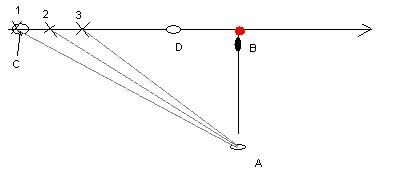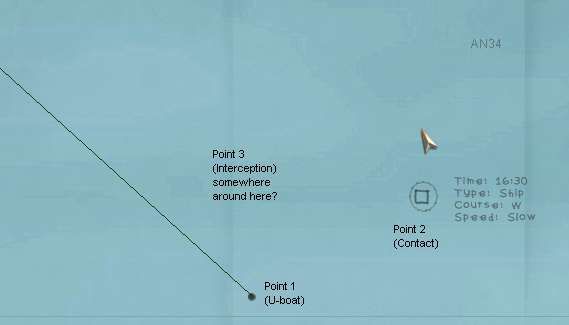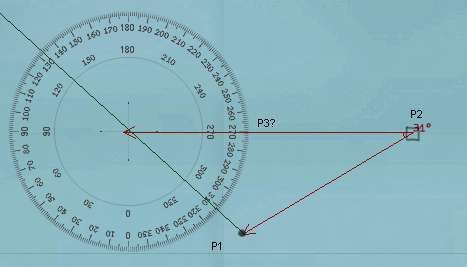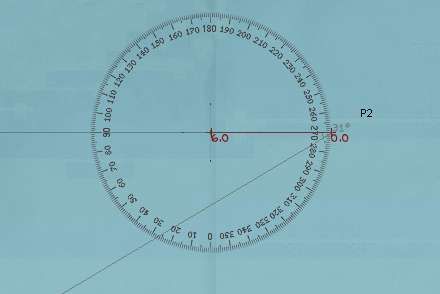Sailor man 
Join Date: Mar 2011
Posts: 47
Downloads: 27
Uploads: 0
|

Intercepting Targets
Learning to Intercept targets is crucial for success in Silent Hunter III.
Table of contents [hide]
1 Introduction
2 Plotting the target's course and speed
3 Finding the intercept point
4 Example intercept
5 Running a Box Pattern Intercept
6 Example box pattern intercept
7 Claren's Easy Course-to-Target Plotting Method
8 See also
9 Other resources
9.1 Silent Hunter III specific
9.2 Historical
Introduction
The goal of a good intercept is to get you into firing range (500-700 meters) with the ship passing right in front of you.
Ideally, your boat should be at exactly 90° to the path of the target facing it as it passes by. This allows you to fire fire your torpedos at 0° Gyro angle. Gyro angles within 10° of 0 work well. Beyond that, your torpedo may fail, or hit at a bad angle. Ensuring that your range is within the 500-700m range, directly abeam of the target, will make your limited supplies of torpedos much more effective.
Plotting the target's course and speed
In order to reach an ideal intercept position, you need to know the target's speed and heading. Both can be determined by submerging at low speed or stopped and taking several hydrophone readings. Note that you must have the No map contact update realism setting disabled for this to work.
You should take several hydrophone readings over time. Zoom in on the end of the black or grey sonar contact line and put an X with the marker there. Ensure that you are zoomed in far enough to see the grid lines, or you won't get a very accurate position fix. Even so, you will be off. The farther the contact, the larger the error. The error will always be one of range, the bearing is accurate.
You should note the exact time of each mark that you make, to be able to later determine the target speed. If possible, try to make each mark at an interval of 3 minutes and 15 seconds. This allows you to use the 3 minute rule to easily calculate the target's speed. In any case, you must know the elapsed time between your marks if you want to know the speed of the target. With hydrophone readings, the updates come about every minute. If you ask the sonarman to follow the nearest contact, they come every 15 seconds or so. So keep in mind the 3 minute rule will be a rough estimate of speed. If you are moving and the target is moving, you can just turn time compression to 64 and eyeball it. You can say pretty fast if the target is moving much faster than you. Getting an exact speed with timing is much faster in game time and will allow you to intecept fast moving targets more often. Fast, for merchants anyway.
Once you have at least 3 marks on the map that are about kilometer or more apart, use the ruler to draw a line from the first one through the last one. This is the ships estimated course. The ships real course will be +/- 5° and +/- 500 meters at 15 Kilometers. Keep in mind this course is an estimate and plan to update it accordingly.
You can now calculate your targets speed (distance = rate x time), or using the 3 minute rule.
Finding the intercept point
A line from your ship that meets the target's course line at 90° is the closest intercept course you have to the target's course. If the target is more or less coming at you, just plot a course that takes you right into its path, minus about 500 meters. Using the target's calculated speed you can determine approximately when the target will arrive near your intercept point. Ensure that your U-boat has enough speed to reach that point well before the target!
It is important not to take a diagonal path compared to the targets course. This will not leave you in a good firing position and you will waste many torpedoes.
Once you get the hang of it, you may want to take a diagonal path to get you further ahead of the target, then make your turn to 90° at the end.
Example intercept
 Sub starts (A) and takes several readings on target (C). Gray lines represent sonar readings. Sub moves to intercept location (B) and arrives early. Target arrives at (D) as sub is settling into position and getting final readings on exact course.
Running a Box Pattern Intercept
If you can't make it into the ships path in time or the target is moving away from you, you need to run a box pattern to get where you need to be. Mark out a course that is exactly parallel to your target's course. Make sure that this course is at least 2KM from the targets course at night or in bad weather. Go at least 5 KM out in clear weather during the day to stay beyond visual range. Surface your boat and make flank speed along this course until you have enough lead to get into position and be submerged when the target arrives. You should stop once in a while and submerge to confirm that the target is still on course. It might take you a full day or more running at top speed on the surface to outflank the target. That's what flank speed is for.
It might also be impossible to overake the target, even at top speed. In that case, dive and set ahead slow the opposite direction along the targets course and hope it's a well travel sea lane.
Example box pattern intercept
Sub starts (A) and takes several readings on target (C). Gray lines represent sonar readings. Sub moves to intercept location (B) and arrives early. Target arrives at (D) as sub is settling into position and getting final readings on exact course.
Running a Box Pattern Intercept
If you can't make it into the ships path in time or the target is moving away from you, you need to run a box pattern to get where you need to be. Mark out a course that is exactly parallel to your target's course. Make sure that this course is at least 2KM from the targets course at night or in bad weather. Go at least 5 KM out in clear weather during the day to stay beyond visual range. Surface your boat and make flank speed along this course until you have enough lead to get into position and be submerged when the target arrives. You should stop once in a while and submerge to confirm that the target is still on course. It might take you a full day or more running at top speed on the surface to outflank the target. That's what flank speed is for.
It might also be impossible to overake the target, even at top speed. In that case, dive and set ahead slow the opposite direction along the targets course and hope it's a well travel sea lane.
Example box pattern intercept
 Sub (A) can't directly intercept target (b) so it runs a box intecept to arrive at (C) before the target. Don't forget to submerge to get sonar readings an confirm the target is still on course.
--SaintD 11:28, 12 May 2005 (EEST)
Claren's Easy Course-to-Target Plotting Method
Note from Dantenoc: --This method produced faulty results, and has been replaced with the correct procedure... I had previously left it alone and had only posted a link to the revised method, but a lot of people kept reading the incorrect version.
Sorry Claren... you allmost had it but you switched around two of the triangles' legs
Sub (A) can't directly intercept target (b) so it runs a box intecept to arrive at (C) before the target. Don't forget to submerge to get sonar readings an confirm the target is still on course.
--SaintD 11:28, 12 May 2005 (EEST)
Claren's Easy Course-to-Target Plotting Method
Note from Dantenoc: --This method produced faulty results, and has been replaced with the correct procedure... I had previously left it alone and had only posted a link to the revised method, but a lot of people kept reading the incorrect version.
Sorry Claren... you allmost had it but you switched around two of the triangles' legs  --End of note
And now for the new and improved revised version. For the short explanation, only read what's on top of the images (after the "Step X:" title and before the picture). For a more complete explanation read the rest also. --End of note
And now for the new and improved revised version. For the short explanation, only read what's on top of the images (after the "Step X:" title and before the picture). For a more complete explanation read the rest also.
Step 1: The setup
One of the biggest reasons for the early success of the u-boat was coordinated intel received from BdU. The germans had broken the british radio codes and regularly intercepted messages that allowed them to know the whereabouts of the enemy boats and convoys. Other sources of such privileged information included sightings by other U-boats and Luftwaffe airplanes, who reported their findings back to headquarters. Silent Hunter III simulates this by ocationaly marking ship icons in your nav-map even though they're way out of your range. If you can succesfully tap into that information, you'll soon become Germany's top U-boat ace without much effort  So let's get on with it.
Your U-boat, located at point 1, receives a contact report of a ship located at point 2. Take notice of the contact's speed and heading, which you can obtain by clicking on him on the nav-map. So let's get on with it.
Your U-boat, located at point 1, receives a contact report of a ship located at point 2. Take notice of the contact's speed and heading, which you can obtain by clicking on him on the nav-map.
 Slow means around 6 knots, medium means about 9 knots, and fast... well, I never bother with those (why? because they're probably warships and Doenitz wants you to concentrate on merchant shiping). Obviously, in cases like these, when the contact is so far away, there's absolutely no point in racing toward the contacts reported location... he won't be there any more by the time you get there. No, rather, our hope is to intercept the ship at some point 3 were we'll both meet. In other words, go to the spot where he is going to be by the time you get there. Now the big question is: where exactly IS that spot?!?!
Step two:
To figure out where the "Intercept point" is, start by clicking on your ship with the protractor tool (marked as P1 on the image), then click on the contact (marked as P2 in the image), and then drag the second leg of the protractor tool off into the direction where the contact is heading. Your nav-map should look like this:
Slow means around 6 knots, medium means about 9 knots, and fast... well, I never bother with those (why? because they're probably warships and Doenitz wants you to concentrate on merchant shiping). Obviously, in cases like these, when the contact is so far away, there's absolutely no point in racing toward the contacts reported location... he won't be there any more by the time you get there. No, rather, our hope is to intercept the ship at some point 3 were we'll both meet. In other words, go to the spot where he is going to be by the time you get there. Now the big question is: where exactly IS that spot?!?!
Step two:
To figure out where the "Intercept point" is, start by clicking on your ship with the protractor tool (marked as P1 on the image), then click on the contact (marked as P2 in the image), and then drag the second leg of the protractor tool off into the direction where the contact is heading. Your nav-map should look like this:
 Step three:
Using the ruler start measuring from the contact's position of into the direction where it's heading. Measure a distance representative of it's speed. In this example the contact was reported as slow, so I measure 6 kms to represent 6 knots. Your nav-map should look like this:
Step three:
Using the ruler start measuring from the contact's position of into the direction where it's heading. Measure a distance representative of it's speed. In this example the contact was reported as slow, so I measure 6 kms to represent 6 knots. Your nav-map should look like this:
 Note that the distance of 6kms used is merely a mnemonic representation of the contact's speed of 6 knots, It has nothing to do with the actual 11.118 kilometers that the ship will travel in one hour at that speed, or anything like that. You could have just as easily used any other scale to represent speed... like for example: 10 kms for every 1 knot, or 0.1 kms for every 1 knot or even weird scales like 2.5 kilometers for every 1 knot. The trick here is to pick a scale that you are most comfortable with and to STICK WITH IT. As long as you are consistent in your scale choice you should have no problems whatsoever.
Note that the distance of 6kms used is merely a mnemonic representation of the contact's speed of 6 knots, It has nothing to do with the actual 11.118 kilometers that the ship will travel in one hour at that speed, or anything like that. You could have just as easily used any other scale to represent speed... like for example: 10 kms for every 1 knot, or 0.1 kms for every 1 knot or even weird scales like 2.5 kilometers for every 1 knot. The trick here is to pick a scale that you are most comfortable with and to STICK WITH IT. As long as you are consistent in your scale choice you should have no problems whatsoever.
|